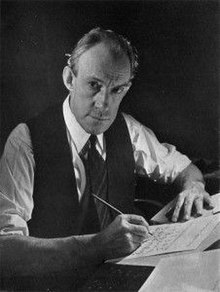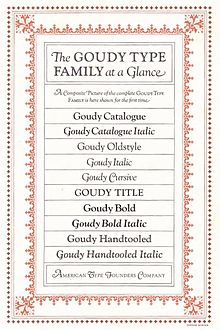American Type Founders
American Type Founders (translated: American type foundries ; abbreviation: ATF) was a coalition of 23 American hot type - type foundries . Until the 1930s, ATF was one of the world's largest font providers. The ATF font range was significantly influenced by the well-known font designer Morris Fuller Benton . Well-known ATF fonts include Franklin Gothic , Hobo , Century Schoolbook, and Goudy Old Style . Due to the changed market situation in the first half of the 20th century, the company was finally dissolved in 1993.
history
The American Type Founders (abbreviation: ATF) came into being in 1893 as a merger of 23 American type foundries - mainly located on the east coast and in the Midwest . In the following decades other companies joined the merger; others concluded distribution or license agreements with the ATF. A major motive for the completed company concentration was the falling sales of hand typesetting - due to the emergence of typesetting machines (mainly promoted by the Linotype and Monotype companies ) . Companies involved in the founding of ATF included:
- from New York City : James Conner's Sons, PA Heinrich and AW Lindsay
- from Philadelphia : MacKellar, Smiths, & Jordan Co., Collins & M'Leester and Binny & Ronaldson
- from Boston : Dickinson Type Foundry and its subsidiary Phelps, Dalton, & Co.
- from Buffalo : Lyman & Son
- from Baltimore : Charles J. Carey & Co., The John Ryan Co., JG Mengel & Co. and Hooper, Wilson & Co.
- from Cincinnati : Allison & Smith and Cincinnati Type Foundry
- from Cleveland : Cleveland Type Foundry of HH Thorpe
- from Chicago : Marder, Luse, & Co. and Union Type Foundry
- from Milwaukee : Benton, Waldo & Co.
- from Kansas City : Kansas City Type Foundry
- from San Francisco : Palmer & Rey
The first catalog of fonts was published in 1895. In 1903 the ATF opened its headquarters in Jersey City , New Jersey . In terms of assortment, the management of the association, which is now operating under one company roof, relied on the bundling and differentiation of the existing range. The production of redundant fonts - a consequence of the heterogeneous range of the individual foundries that have merged into the ATF - was discontinued, but successful ones were merged and marketed in the form of compact font families . The creative head of the company and artistic director responsible for the program was Morris Fuller Benton. While Morris Fuller was mainly responsible for the creative profile of the ATF, his father, the typographer and inventor Linn Boyd Benton , who was involved in the founding of the ATF , initiated some pantographic innovations that help improve the optical quality and legibility of the individual font sizes has been optimized.
The success and - as a result - the good reputation of ATF was largely based on the quality of the fonts sold and the reputation of those responsible for typography. From 1900, the typeface designer Morris Fuller Benton - who had joined the company four years earlier as his father's assistant - was in charge of the typeface program. Benton designed a number of typefaces for the ATF, which are still among the standards of American typography today: Franklin Gothic, Alternate Gothic, Bank Gothic, Cheltenham , Century Schoolbook, Hobo and in-house versions of the classic typefaces Garamond and Bodoni . Other typeface designers such as Frederic Goudy , Warren Chappell , Oswald Cooper and Joseph B. Phinney added to the ATF range - some with typefaces that are still classics of US typography, such as the two Goudy typefaces Copperplate and Goudy Old style.
For several decades, ATF achieved a quasi-monopoly position on the American market: Due to its extensive presence, the merger soon covered around 85 percent of the demand for metal type in the USA. One expression of the dominant market situation that ATF had meanwhile achieved was the font sample catalog from 1923 - a renowned product with over 1100 pages and printed in full color. In the wake of the global economic crisis from 1929, the company's sales plummeted. The font sales decreased significantly; In addition, it turned out that the infrastructure was severely overstretched. In 1933 the ATF filed for bankruptcy . American Type Founders managed to get over the years of depression thanks to drastic streamlining measures.
Regardless of the consolidation in the 1930s, the company was unable to regain its former position. In 1959 the ATF was bought by the machine manufacturer Whitin Machine Works. Attempts in the emerging market for phototypesetting machines to establish, could not stop the decline of the company. In 1986 the company became the property of the foil stamping company Kingsley and then operated under the label name Kingsley-ATF. In 1993 production was finally stopped and part of the inventory - including the matrices for the type casting - was auctioned off.
Analog and digital inheritance
An early branch of the ATF was the ATF Library & Museum . Under the aegis of the photographer Henry Lewis Bullen, she archived prints , typeface samples as well as manuscripts and records. Located at the company's headquarters in Jersey City until 1933, it served on the one hand as a reference collection for the company itself and on the other hand as a cultural institution to maintain the printing culture . Pending for sale after bankruptcy in 1933, the holdings were taken over by New York's Columbia University in 1941 and made available as the university's own collection.
The fonts from the ATF portfolio were licensed by various distributors as early as the 20th century and then distributed accordingly - including Linotype, Monotype, Adobe and the German manufacturer URW ++ . A number of ATF fonts are among the classics of the 20th century; the ranking of the 100 best typefaces from 2007 carried out by the font distributor FontShop lists the ATF typefaces Franklin Gothic, Bank Gothic, Copperplate and News Gothic in its compilation. Franklin Gothic is also the best-known American sans serif and a prime example of the American grotesque font classification subgroup . A few smaller American font distributors such as P22 or Red Rooster Collection are also dedicated to digitally maintaining the ATF font inventory. The ATF Collection , a font label operated by a company in Berkeley , California , has specialized in the new edition of classic ATF fonts .
Individual evidence
- ↑ a b American Type Founders (ATF) . Ralf Herrmann, typografie.info, February 10, 2013
- ↑ a b American Type Founders . Info text about the ATF on the website of the Klingspor Museum , Offenbach, accessed on September 2, 2016 (PDF)
- ↑ American Type Founders Company: A legacy of typographic innovation, quality, and creativity . John D. Berry, atftype.com, accessed September 2, 2016
- ↑ The 100 best writings ( Memento from June 16, 2016 in the Internet Archive ). FontShop, Berlin 2007, page 9 (PDF).
- ↑ American Type Founders Specimen Book , carsonparkdesign.com, accessed September 2, 2016 (Engl.)
- ↑ a b Kingsley ATF . Portrait of the ATF in the font portal MyFonts.com, accessed on September 2, 2016 (Engl.)
- ^ The American Type Founders Company . Columbia University Libraries, accessed September 2, 2016
- ↑ see: The 100 best writings ( Memento from June 16, 2016 in the Internet Archive ). FontShop, Berlin 2007 (PDF). In HTML form online: here
- ^ American Type Founders Collection . Website of the font label of the same name. Accessed September 2, 2016 (Engl.)
- ↑ "American Type Founders Collection": Typeface classics reinterpreted . Typo and graphic design weblog dasauge.de, accessed on September 2, 2016
Web links
- Linn Boyd Benton, Morris Fuller Benton and Typemaking at ATF . Patricia A. Cost, accessed on September 2, 2016 (English, PDF)


